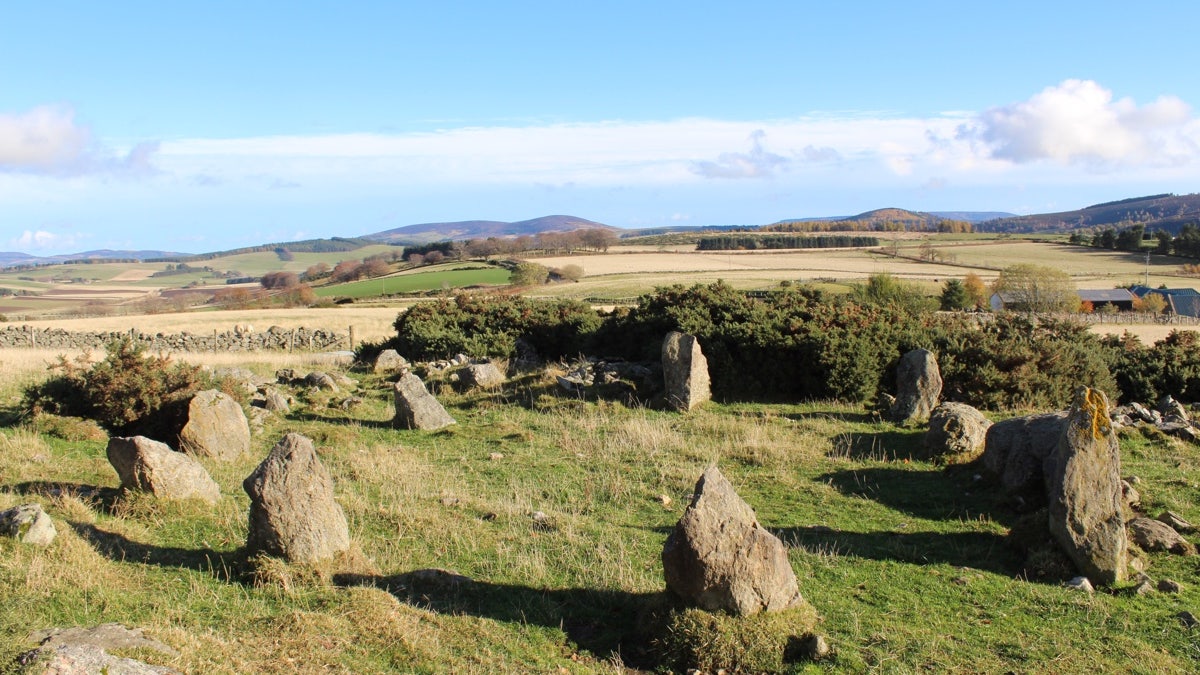
The Neolithic stone circle near the village of Alford, west of Aberdeen, was unknown to archaeologists until recently – but well-known to local people. (Neil Ackerman/Aberdeenshire Council Archaeology Service)
A Neolithic circle of standing stones was recently "discovered" by archaeologists in Scotland. But it turns out, local farmers have known about it for generations.
The ancient monumental structure — thought to be between 3,500 and 4,500 years old — consists of 10 stones, each about 3 feet (1 meter) high, standing in a circle about 25 feet (7.7 m) across.
The stone circle is located in a remote patch of farmland near the village of Alford, about 25 miles (40 kilometers) west of Aberdeen. [See Photos of the Ancient Stone Circle in Scotland]
The monument is an example of a "recumbent" stone circle, a Neolithic style unique to the northeast of Scotland and the south-west of Ireland. This style has a large "recumbent" stone lying on its side between two upright stones, or "flankers," in the southwest of the circle.
More From LiveScience
A member of the Aberdeenshire Council archaeological team, Neil Ackerman, told Live Science that the stone circle was "discovered" by archaeologists only in November of last year, after the land where it was located was sold.
One of the former land owners, Fiona Bain, mentioned to council archaeologists that she had tried to find out more about the mysterious stone circle, but she couldn't find any records of it, Ackerman said.
As a result, archaeologists from Aberdeenshire Council and the Historic Environment Scotland agency visited the site and surveyed the stone circle, he said.
"It really doesn't get much better than this," Ackerman said. "A lot of the recumbent stone circles that people have known about for a very long time only have two or three stones left — so to have one that is complete is quite unusual."
Local knowledge
Several local people were familiar with the stone circle near Alford, in part, because they walked their dogs at a nearby track.
One member of a local farming family, now in her 80s, remembered seeing the stone circle at some time in the 1930s, Ackerman said. But the circle was in farmland, far from the main roads in the area, and had remained unknown to archaeologists until now, he said.
Before the latest discovery, the last complete stone circle was recorded in the area about 50 years ago.
Some other ancient recumbent stone circles in the area had been damaged when their stones were removed for other purposes; some others were completely destroyed, and only the settings of the ancient stones can now be seen, he said.
Ackerman said the stone circle near Alford may be one of the last complete stone circles that will be found in the northeast of Scotland.
"There are a few bits of Aberdeenshire and the northeast of Scotland in general that aren't as well-surveyed as other areas — and this is one of the areas that had less work done on it in the past," he said.
Now that archaeologists have professionally surveyed the stone circle, it will be included in future research into Neolithic stone monuments in the region, he said.
Recumbent stone circles
Neolithic stone circles with a large "recumbent" stone are found only in the northeast of Scotland and the southwest of Ireland , although thousands of Neolithic circles without recumbent stones are found in other parts of Britain and Europe.
The distribution of recumbent stone circles in Scotland has also been linked to the manufacture of intricately carved stone balls — another unusual type of Neolithic artwork.
The stone circles, Ackerman said, were often built on top of even earlier cairns of rocks and were used at later dates in prehistory for the burial of cremated human remains.
"The monument you see as the finished recumbent stone circle is the last stage, as it were, in a fairly long life of monument use, which is kind of normal for prehistory — people like building stuff on important places," he said. [In Photos: A Walk Through Stonehenge]
Most recumbent stone circles were larger than 36 feet (11 m) across, making the circle near Alford a relatively small example of its kind. It is also one of the westernmost recumbent stone circles yet found, he said.
The stone circle was located on high ground with good views of the surrounding area, which may explain why it was built there, he said.
Like many others in Scotland's northeast, the stone circle near Alford is oriented with its large recumbent stone in the southwest of the circle. Some researchers think this orientation reflects the location of the midwinter sunset, which would have been an important date for Neolithic farming peoples.
But Ackerman said there was still a great deal of debate among archaeologists about why the stone circles are orientated as they are. "If you wait long enough, it's going to line up with something," he said.
- In Photos: Intricately Carved Stone Balls Puzzle Archaeologists
- In Photos: Mysterious Stone Structures in Saudi Arabia
- The 25 Most Mysterious Archaeological Finds on Earth
Original article on Live Science.
